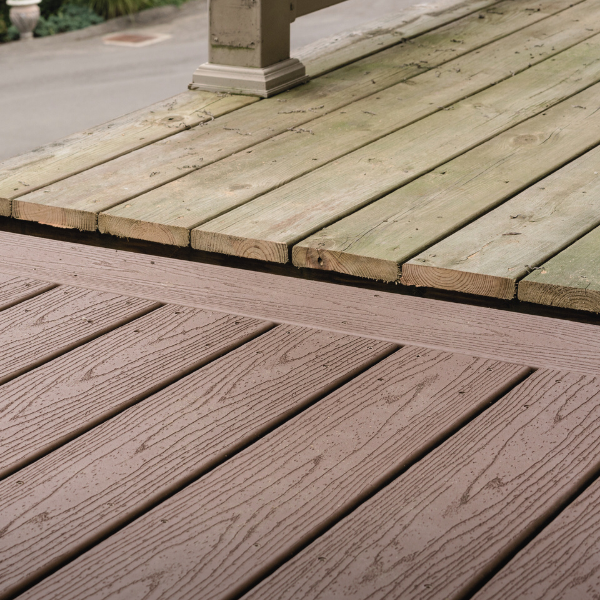
For the environmentally conscious, picking an eco-friendly construction material is an essential factor in building projects. Aside from durability, longevity, and appearance – the amount of CO2 produced, energy costs involved, and safe disposal of a material are important factors to consider.
Is timber sustainable? Is composite more environmentally friendly than wood? Whether you’re thinking of getting timber decking, or composite cladding, here are the environmental factors to consider when picking your materials. By the end, you should know whether oak or composite is better for the environment.
What is Wood Composite?
Timber is timber, but what is wood composite? It’s typically a mix of wood fibre and sawdust, blended together with a binding material to create a plank-like board. The most common binding materials are plastics like polythene or polyvinyl.
You can find composites made with plastic-free “bio-materials” and natural adhesives on the market. However, these boards are often pricier than the cheap plastic variety.
Wood composite boards looks very similar to natural wood, and you might not be able to tell the difference between timber decking and composite decking at first. Visually, it’s made to look just like wood, but one touch, and you can tell the texture isn’t the same. Composite also tends to be much lighter than wood, thanks to the inclusion of plastics.
Timber Vs Composite
| Oak Timber | Wood Composite |
| 100% natural wood | Mix of wood fibres and plastics (or natural adhesives) |
| Structurally strong and suitable for use in construction and oak fencing | Weaker, unsuitable for fencing, and requires reinforcement for use in decking |
| Can last over 100 years (with good maintenance) | Lasts up to 30 years (with or without good maintenance) |
| Fully biodegradable | Plastic composites are not biodegradable |
| Reusable and recyclable | Recycling process is resource intensive |
How Sustainable is Wood Composite?
You may think wood composites are an ingenious way to reduce wood waste, but you have to think of the full life-cycle of the product. Because the majority of wood composite boards use plastic as the binding material, they cannot be biodegraded. Their recycling process requires “pyrolysis” or burning off the plastic to use with a fresh set of wood fibres. Only plastic-free wood composite boards benefit from being biodegradable and easy to recycle.
The Sustainable Lifecycle of Wood Composite
| Stage | Sustainability |
| Sourcing of materials | This typically uses wood off-cuts and recycled plastic polymers, reducing lumber waste. |
| The manufacturing process | Machinery processing the wood fibres and preparing the plastic polymers is quite energy and resource intensive. |
| Usage and lifecycle | The boards last up to 30 years and do not require much maintenance. |
| End of life | Recycling is the only sustainable option for plastic-based boards, which requires a lot of energy. This can only be done so many times before the plastic is unusable. |
Is Timber Sustainable?
Timber is a construction material with a very low carbon footprint compared to wood composite and other construction materials. Timber lasts for generations with good maintenance and traps carbon that would otherwise increase the amount of CO2 in the atmosphere.
Of course, the sourcing of timber contributes to deforestation and habitat loss in nature if not done so sustainably. Planting trees to replace ones that are cut, and using tree plantations to grow wood, minimises impact on wild habitats.
The Sustainable Timber Lifecycle
| Stage | Sustainability |
| Sourcing of materials | Tree farms, and planting new saplings to replace cut trees, are the most sustainable timber options. |
| The manufacturing process | Cutting wood into timber is a relatively quick, non-intensive process. Lamination for construction timber is less resource intensive than the production of wood composite. |
| Usage and lifecycle | Wood lasts generations and can be reused in a number of ways, so long that it is well maintained. There is less impact on the environment if natural wood oils and paints are used for maintenance. |
| End of life | Unusable wood can be broken into chipboard, mulch, pellets, etc. It’s fully biodegradable. |
How We Source Sustainable at Celtic Timber
At Celtic Timber we donate to several tree-planting, rewilding, and environmentally friendly wood programs with a minimum commitment of £3,000 per year. Every time you buy oak fencing, or other timber products from us, rest assured that part of the profits go to these environmental projects. You can read all about it on our carbon footprint page.
We don’t pretend that sustainable timber doesn’t require investment and commitment towards making it a renewable resource. That’s why we do everything we can to reduce wood waste in our workshops. We use aged oak barrels that breweries and distilleries don’t want anymore and repurpose them into planters, baths, and more!
